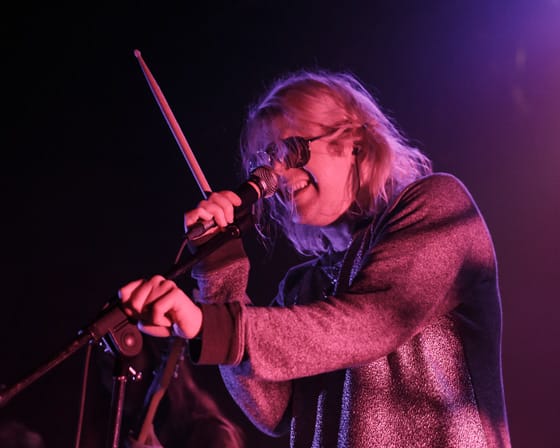Ariel Pink's lanky build and post-Cobain hairdo were only the surface of the odd presence that he brought with him to the Rickshaw Theatre. After unconfidently greeting the audience, he asked for more smoke to fill the stage, at first jokingly, but eventually he grew insistent about it, demanding more smoke before he could start. By the time he started playing, it seemed pretty clear that the man behind the oversized reflective shades was not intent on acknowledging the audience directly.
Backing Ariel was a five-piece band with characters as diverse and intriguing as himself. The group of multi-instrumentalists provided the rich sonic arrangements characteristic of the Haunted Graffiti with guitars, synthesizers and vocals ranging from rich harmonies to bizarre character impersonations. The cherry on top was a saxophone that was only ever played when doubled by Ariel's own vocalized saxophone impression.
True to Pink's recorded material, his concert performance is structured as a schizophrenically sequenced stream of consciousness, with themes and twists constantly taking turns for the weirder. However, between the moments of Frank Zappa-esque pastiche and beneath a constant sense of tongue-in-cheekness, there were moments of absolute emotional sincerity creeping into the most unexpected places, such as in the dystopian "Not Enough Violence," which vents the surprisingly relatable frustrations of humans being farmed for power.
Pink's unpredictable presence wasn't the only theatrical element of the show. The band staged an entire scene true to the album version of "Black Ballerina," featuring Ariel as Billy, an archetypically shy boy, whose first encounter with a topless dancer — voiced by the drummer sporting a police hat — ends predictably disastrously. Finishing off over the song's neurotically looping synth bass, the lead character starts speaking in reverse as fluently as the impish man from another place in Twin Peaks.
The band played the bulk of Pom Pom, which the drummer later cheekily referred to as Ariel Pink's Pink Album. Beyond the face value similarity to the seminal White Album, the sheer size of the 17-track effort, coupled with the range of ideas packed in it, make it a surprisingly mature release, one that could make for a great children's album too. The band followed it up with a more subdued encore, lulling the audience with some of the more dreamy and straightforwardly lovable songs from past records.
Opening act Jack Name were quite the foil for Ariel's magical mystery show, a trio tightly huddled around a nest of electronics and guitars playing hypnotic Krautrock-tinged pieces with a cool and composed manner. In contrast to the comfort of the introverted psychedelia of the openers, Pink's extroverted sonic and verbal barrage was one that forced you to engage.
Backing Ariel was a five-piece band with characters as diverse and intriguing as himself. The group of multi-instrumentalists provided the rich sonic arrangements characteristic of the Haunted Graffiti with guitars, synthesizers and vocals ranging from rich harmonies to bizarre character impersonations. The cherry on top was a saxophone that was only ever played when doubled by Ariel's own vocalized saxophone impression.
True to Pink's recorded material, his concert performance is structured as a schizophrenically sequenced stream of consciousness, with themes and twists constantly taking turns for the weirder. However, between the moments of Frank Zappa-esque pastiche and beneath a constant sense of tongue-in-cheekness, there were moments of absolute emotional sincerity creeping into the most unexpected places, such as in the dystopian "Not Enough Violence," which vents the surprisingly relatable frustrations of humans being farmed for power.
Pink's unpredictable presence wasn't the only theatrical element of the show. The band staged an entire scene true to the album version of "Black Ballerina," featuring Ariel as Billy, an archetypically shy boy, whose first encounter with a topless dancer — voiced by the drummer sporting a police hat — ends predictably disastrously. Finishing off over the song's neurotically looping synth bass, the lead character starts speaking in reverse as fluently as the impish man from another place in Twin Peaks.
The band played the bulk of Pom Pom, which the drummer later cheekily referred to as Ariel Pink's Pink Album. Beyond the face value similarity to the seminal White Album, the sheer size of the 17-track effort, coupled with the range of ideas packed in it, make it a surprisingly mature release, one that could make for a great children's album too. The band followed it up with a more subdued encore, lulling the audience with some of the more dreamy and straightforwardly lovable songs from past records.
Opening act Jack Name were quite the foil for Ariel's magical mystery show, a trio tightly huddled around a nest of electronics and guitars playing hypnotic Krautrock-tinged pieces with a cool and composed manner. In contrast to the comfort of the introverted psychedelia of the openers, Pink's extroverted sonic and verbal barrage was one that forced you to engage.
